Bioactive Chemical Constituents of Matthiola longipetala Extract Showed Antioxidant, Antibacterial, and Cytotoxic Potency
Abstract
:1. Introduction
2. Materials and Methods
2.1. Plant Materials Collection, Preparation, and Extraction
2.2. Gas Chromatography-Mass Spectrometry (GC-MS) of the Extract
2.3. Antioxidant Activity Assay of M. longipetala Extracts
2.3.1. DPPH Assay
2.3.2. ABTS Assay
2.4. Antibacterial Activity Assay
2.5. Cytotoxicity and Cell Proliferation
2.6. Assay of Cell Motility
2.7. Conventional PCR
2.8. Statistical Analysis
3. Results and Discussion
3.1. Chemical Characterization of M. longipetala Extract
3.2. Biological Activities of the M. longipetala Extracts
3.2.1. Antioxidant Activity
3.2.2. Antibacterial Activity
3.2.3. Cytotoxicity and Cell Migration Analysis
DNA Fragmentation
The EC50 Value of M. longipetala Extract
4. Conclusions
Author Contributions
Funding
Institutional Review Board Statement
Informed Consent Statement
Data Availability Statement
Acknowledgments
Conflicts of Interest
References
- Shahrajabian, M.H.; Sun, W.; Cheng, Q. A review of ginseng species in different regions as a multipurpose herb in traditional Chinese medicine, modern herbology and pharmacological science. J. Med. Plants Res. 2019, 13, 213–226. [Google Scholar]
- Çelik Yılmaz, N.; Yılmaz, A.; Yılmaz, F. Coloring of Woolen Fabrics with Natural Resources and Investigating the Color Perceptions of Children on These Fabrics. J. Nat. Fibers 2023, 20, 2134269. [Google Scholar] [CrossRef]
- El-Amier, Y.A.; Abdelghany, A.M.; Abed Zaid, A. Green synthesis and antimicrobial activity of Senecio glaucus-mediated silver nanoparticles. Res. J. Pharm. Bio. Chem. Sci. 2014, 5, 631–642. [Google Scholar]
- Al-Rowaily, S.L.; Abd-ElGawad, A.M.; Assaeed, A.M.; Elgamal, A.M.; Gendy, A.E.-N.G.E.; Mohamed, T.A.; Dar, B.A.; Mohamed, T.K.; Elshamy, A.I. Essential oil of Calotropis procera: Comparative chemical profiles, antimicrobial activity, and allelopathic potential on weeds. Molecules 2020, 25, 5203. [Google Scholar] [CrossRef]
- Abd El-Gawad, A.M.; El-Amier, Y.A.; Bonanomi, G. Essential oil composition, antioxidant and allelopathic activities of Cleome droserifolia (Forssk.) Delile. Chem. Biodivers. 2018, 15, e1800392. [Google Scholar] [CrossRef]
- David, B.; Wolfender, J.-L.; Dias, D.A. The pharmaceutical industry and natural products: Historical status and new trends. Phytochem. Rev. 2015, 14, 299–315. [Google Scholar] [CrossRef]
- Fayed, E.M.; Abd-EIGawad, A.M.; Elshamy, A.I.; El-Halawany, E.S.F.; El-Amier, Y.A. Essential oil of Deverra tortuosa aerial parts: Detailed chemical profile, allelopathic, antimicrobial, and antioxidant activities. Chem. Biodivers. 2021, 18, e2000914. [Google Scholar] [CrossRef]
- Boulos, L. Flora of Egypt 1: Azollaceae–Oxalidaceae; Al Hadara Publishing: Cairo, Egypt, 1999. [Google Scholar]
- Jaén-Molina, R.; Caujapé-Castells, J.; Reyes-Betancort, J.A.; Akhani, H.; Fernández-Palacios, O.; de Paz, J.P.; Febles-Hernández, R.; Marrero-Rodríguez, Á. The molecular phylogeny of Matthiola R. Br. (Brassicaceae) inferred from ITS sequences, with special emphasis on the Macaronesian endemics. Mol. Phylogenetics Evol. 2009, 53, 972–981. [Google Scholar] [CrossRef]
- Canli, K.; Bozyel, M.E.; Benek, A.; Yetgin, A.; Senturan, M.; Altuner, E.M. Chemical composition and in vitro antimicrobial activity of Matthiola tricuspidata ethanol extract. Fresenius Environ. Bull. 2020, 29, 8863–8868. [Google Scholar]
- Miceli, N.; Cavò, E.; Ragusa, S.; Cacciola, F.; Dugo, P.; Mondello, L.; Marino, A.; Cincotta, F.; Condurso, C.; Taviano, M.F. Phytochemical characterization and biological activities of a hydroalcoholic extract obtained from the aerial parts of Matthiola incana (L.) R. Br. subsp. incana (Brassicaceae) growing wild in Sicily (Italy). Chem. Biodivers. 2019, 16, e1800677. [Google Scholar] [CrossRef]
- Miceli, N.; Cavò, E.; Spadaro, V.; Raimondo, F.M.; Ragusa, S.; Cacciola, F.; El Majdoub, Y.O.; Arena, K.; Mondello, L.; Condurso, C. Phytochemical profile and antioxidant activity of the aerial part extracts from Matthiola incana subsp. rupestris and subsp. pulchella (Brassicaceae) endemic to Sicily. Chem. Biodivers. 2021, 18, e2100167. [Google Scholar] [CrossRef] [PubMed]
- Schroder, H.S.; Dawood, S.; Yalch, M.M.; Donnellan, M.B.; Moser, J.S. The role of implicit theories in mental health symptoms, emotion regulation, and hypothetical treatment choices in college students. Cogn. Ther. Res. 2015, 39, 120–139. [Google Scholar] [CrossRef]
- Rasool, N.; Afzal, S.; Riaz, M.; Rashid, U.; Rizwan, K.; Zubair, M.; Ali, S.; Shahid, M. Evaluation of antioxidant activity, cytotoxic studies and GC-MS profiling of Matthiola incana (stock flower). Legume Res. 2013, 36, 21–32. [Google Scholar]
- Taviano, M.F.; Cavò, E.; Spadaro, V.; Raimondo, F.M.; Musolino, V.; Cacciola, F.; El Majdoub, Y.O.; Mondello, L.; Condurso, C.; Cincotta, F. Phytochemical constituents, antioxidant activity, and toxicity assessment of the aerial part extracts from the infraspecific taxa of Matthiola fruticulosa (Brassicaceae) endemic to Sicily. Molecules 2021, 26, 4114. [Google Scholar] [CrossRef] [PubMed]
- Karaman, S.; Gulseven, M.; Comlekcioglu, N.; Ilcim, A. Fatty acid composition of Matthiola longipetala ssp. bicornis from Turkey. Int. J. Agric. Biol. 2011, 13, 581–585. [Google Scholar]
- Tatsuzawa, F. Acylated anthocyanins in flowers of Matthiola tricuspidata (L.) R. Br. and Matthiola fruticulosa (L.) Maire (Brassicaceae). Biochem. Syst. Ecol. 2014, 100, 399–402. [Google Scholar] [CrossRef]
- Blažević, I.; Đulović, A.; Burčul, F.; Popović, M.; Montaut, S.; Bilušić, T.; Vrca, I.; Markić, J.; Ljubenkov, I.; Ruščić, M. Stability and bioaccessibility during ex vivo digestion of glucoraphenin and glucoraphasatin from Matthiola incana (L.) R. Br. J. Food Compos. Anal. 2020, 90, 103483. [Google Scholar] [CrossRef]
- Hammami, S.; Khoja, I.; Khoja, I.; Jannet, H.B.; Halima, M.B.; Mighri, Z. Flowers essential oil composition of Tunisian Matthiola longipetala and its bioactivity against Tribolium confusum insect. J. Essent. Oil Bear. Plants 2007, 10, 162–167. [Google Scholar] [CrossRef]
- Hammami, S.; Ciavatta, M.L.; Ben Jannet, H.; Cimino, G.; Mighria, Z. Three phenolic and a sterol glycosides identified for the first time in Matthiola longipetala growing in Tunisia. Croat. Chem. Acta 2006, 79, 215–218. [Google Scholar]
- Souza, M.M.; Silva, B.D.; Costa, C.S.; Badiale-Furlong, E. Free phenolic compounds extraction from Brazilian halophytes, soybean and rice bran by ultrasound-assisted and orbital shaker methods. An. Acad. Bras. Cienc. 2018, 90, 3363–3372. [Google Scholar] [CrossRef]
- Miguel, M.G. Antioxidant activity of medicinal and aromatic plants. Flavour Fragr. J. 2010, 25, 291–312. [Google Scholar] [CrossRef]
- Re, R.; Pellegrini, N.; Proteggente, A.; Pannala, A.; Yang, M.; Rice-Evans, C. Antioxidant activity applying an improved ABTS radical cation decolorization assay. Free. Radic. Biol. Med. 1999, 26, 1231–1237. [Google Scholar] [CrossRef]
- Murray, P.R.; Baroon, E.J.; Faller, M.A.; Tenover, F.C.; Yolken, R.H. Manual of Clinical Microbiology, 6th ed.; American Society for Microbiology: Washington, DC, USA, 1482. [Google Scholar]
- Zhu, Q.; Jiang, L.; Wang, X. The expression of Duffy antigen receptor for chemokines by epithelial ovarian cancer decreases growth potential. Oncol. Lett. 2017, 13, 4302–4306. [Google Scholar] [CrossRef] [Green Version]
- Pijuan, J.; Barceló, C.; Moreno, D.F.; Maiques, O.; Sisó, P.; Marti, R.M.; Macià, A.; Panosa, A. In vitro cell migration, invasion, and adhesion assays: From cell imaging to data analysis. Front. Cell Dev. Biol. 2019, 7, 107. [Google Scholar] [CrossRef] [Green Version]
- Abdelshafeek, K.A.; Abdelmohsen, M.M.; Hamed, A.; Shahat, A.A. Investigation of some chemical constituents and antioxidant activity extracts of Matthiola longipetala subsp. longipetala. Chem. Nat. Compd. 2013, 49, 539–543. [Google Scholar] [CrossRef]
- Beevi, S.S.; Narasu, M.L.; Gowda, B.B. Polyphenolics profile, antioxidant and radical scavenging activity of leaves and stem of Raphanus sativus L. Plant Foods Hum. Nutr. 2010, 65, 8–17. [Google Scholar] [CrossRef]
- Chinnarasu, C.; Montes, A.; Pereyra, C.; Casas, L.; Fernández-Ponce, M.T.; Mantell, C.; Pattabhi, S.; de la Ossa, E.M. Preparation of polyphenol fine particles potent antioxidants by a supercritical antisolvent process using different extracts of Olea europaea leaves. Korean J. Chem. Eng. 2016, 33, 594–602. [Google Scholar] [CrossRef]
- Assaeed, A.; Elshamy, A.; El Gendy, A.E.-N.; Dar, B.; Al-Rowaily, S.; Abd-ElGawad, A. Sesquiterpenes-rich essential oil from above ground parts of Pulicaria somalensis exhibited antioxidant activity and allelopathic effect on weeds. Agronomy 2020, 10, 399. [Google Scholar] [CrossRef] [Green Version]
- Abd-ElGawad, A.M.; Elgamal, A.M.; El-Amier, Y.A.; Mohamed, T.A.; El Gendy, A.E.-N.G.; Elshamy, A.I. Chemical composition, allelopathic, antioxidant, and anti-inflammatory activities of sesquiterpenes rich essential oil of Cleome amblyocarpa Barratte & Murb. Plants 2021, 10, 1294. [Google Scholar]
- Mbaveng, A.T.; Hamm, R.; Kuete, V. 19—Harmful and Protective Effects of Terpenoids from African Medicinal Plants. In Toxicological Survey of African Medicinal Plants; Kuete, V., Ed.; Elsevier: Waltham, MA, USA, 2014; pp. 557–576. [Google Scholar]
- Baccouri, B.; Rajhi, I. Terpenes and Terpenoids Recent Advances; IntechOpen: London, UK, 2021. [Google Scholar]
- Ghorbani, A.; Esmaeilizadeh, M. Pharmacological properties of Salvia officinalis and its components. J. Tradit. Complement. Med. 2017, 7, 433–440. [Google Scholar] [CrossRef]
- Elshamy, A.; Abd-ElGawad, A.M.; El-Amier, Y.A.; El Gendy, A.; Al-Rowaily, S. Interspecific variation, antioxidant and allelopathic activity of the essential oil from three Launaea species growing naturally in heterogeneous habitats in Egypt. Flavour Fragr. J. 2019, 34, 316–328. [Google Scholar] [CrossRef]
- Abd-ElGawad, A.M.; Elshamy, A.I.; El-Amier, Y.A.; El Gendy, A.E.-N.G.; Al-Barati, S.A.; Dar, B.A.; Al-Rowaily, S.L.; Assaeed, A.M. Chemical composition variations, allelopathic, and antioxidant activities of Symphyotrichum squamatum (Spreng.) Nesom essential oils growing in heterogeneous habitats. Arab. J. Chem. 2020, 13, 4237–4245. [Google Scholar] [CrossRef]
- Darughe, F.; Barzegar, M.; Sahari, M.A. Antioxidant and antifungal activity of coriander (Coriandrum sativum L.) essential oil in cake. Int. Food Res. J. 2012, 19, 1253–1260. [Google Scholar]
- Rudbäck, J.; Bergström, M.A.; Börje, A.; Nilsson, U.; Karlberg, A.T. α-Terpinene, an antioxidant in tea tree oil, autoxidizes rapidly to skin allergens on air exposure. Chem. Res. Toxicol. 2012, 25, 713–721. [Google Scholar] [CrossRef] [PubMed] [Green Version]
- Parveen, Z.; Nawaz, S.; Siddique, S.; Shahzad, K. Composition and antimicrobial activity of the essential oil from leaves of Curcuma longa L. Kasur variety. Indian J. Pharm. Sci. 2013, 75, 117–122. [Google Scholar] [CrossRef] [Green Version]
- Monzote, L.; Stamberg, W.; Staniek, K.; Gille, L. Toxic effects of carvacrol, caryophyllene oxide, and ascaridole from essential oil of Chenopodium ambrosioides on mitochondria. Toxicol. Appl. Pharmacol. 2009, 240, 337–347. [Google Scholar] [CrossRef]
- Chittiboyina, A.G.; Avonto, C.; Khan, I.A. What happens after activation of ascaridole? Reactive compounds and their implications for skin sensitization. Chem. Res. Toxicol. 2016, 29, 1488–1492. [Google Scholar] [CrossRef]
- Sosa, A.A.; Bagi, S.H.; Hameed, I.H. Analysis of bioactive chemical compounds of Euphorbia lathyrus using gas chromatography-mass spectrometry and fourier-transform infrared spectroscopy. J. Pharmacogn. Phytother. 2016, 8, 109–126. [Google Scholar]
- Al-Snafi, A.E. The medical benefit of Gnaphalium luteoalbum-A review. IOSR J. Pharm. 2019, 9, 40–44. [Google Scholar]
- Lu-Martínez, A.A.; Báez-González, J.G.; Castillo-Hernández, S.; Amaya-Guerra, C.; Rodríguez-Rodríguez, J.; García-Márquez, E. Studied of Prunus serotine oil extracted by cold pressing and antioxidant effect of P. longiflora essential oil. J. Food Sci. Technol. 2021, 58, 1420–1429. [Google Scholar] [CrossRef]
- Alam, M.N.; Bristi, N.J.; Rafiquzzaman, M. Review on in vivo and in vitro methods evaluation of antioxidant activity. Saudi Pharm. J. 2013, 21, 143–152. [Google Scholar] [CrossRef] [PubMed] [Green Version]
- Li, Y.X.; Li, Y.; Qian, Z.J.; Kim, M.M.; Kim, S.K. In vitro antioxidant activity of 5-HMF isolated from marine red alga Laurencia undulata in free radical mediated oxidative systems. J. Microbiol. Biotechnol. 2009, 19, 1319–1327. [Google Scholar] [CrossRef] [PubMed] [Green Version]
- Gu, F.; Kim, J.M.; Hayat, K.; Xia, S.; Feng, B.; Zhang, X. Characteristics and antioxidant activity of ultrafiltrated Maillard reaction products from a casein–glucose model system. Food Chem. 2009, 117, 48–54. [Google Scholar] [CrossRef]
- Salehi, B.; Krochmal-Marczak, B.; Skiba, D.; Patra, J.K.; Das, S.K.; Das, G.; Popović-Djordjević, J.B.; Kostić, A.Ž.; Anil Kumar, N.V.; Tripathi, A.; et al. Convolvulus plant-A comprehensive review from phytochemical composition to pharmacy. Phytother. Res. 2020, 34, 315–328. [Google Scholar] [CrossRef]
- Maccelli, A.; Vitanza, L.; Imbriano, A.; Fraschetti, C.; Filippi, A.; Goldoni, P.; Maurizi, L.; Ammendolia, M.G.; Crestoni, M.E.; Fornarini, S.; et al. Satureja montana L. essential oils: Chemical profiles/phytochemical screening, antimicrobial activity and o/w nanoemulsion formulations. Pharmaceutics 2020, 12, 7. [Google Scholar] [CrossRef] [PubMed] [Green Version]
- Brahim, M.A.S.; Fadli, M.; Hassani, L.; Boulay, B.; Markouk, M.; Bekkouche, K.; Abbad, A.; Ali, M.A.; Larhsini, M. Chenopodium ambrosioides var. ambrosioides used in Moroccan traditional medicine can enhance the antimicrobial activity of conventional antibiotics. Ind. Crops Prod. 2015, 71, 37–43. [Google Scholar] [CrossRef]
- Shareef, H.K.; Muhammed, H.J.; Hussein, H.M.; Hameed, I.H. Antibacterial effect of ginger (Zingiber officinale) roscoe and bioactive chemical analysis using gas chromatography mass spectrum. Orient. J. Chem. 2016, 32, 20–40. [Google Scholar]
- Abd El-Gawad, A.; El Gendy, A.; Elshamy, A.; Omer, E. Chemical composition of the essential oil of Trianthema portulacastrum L. Aerial parts and potential antimicrobial and phytotoxic activities of its extract. J. Essent. Oil Bear. Plants 2016, 19, 1684–1692. [Google Scholar] [CrossRef]
- Li, F.-S.; Weng, J.-K. Demystifying traditional herbal medicine with modern approach. Nat. Plants 2017, 3, 17109. [Google Scholar]
- Zaki, F.N. Field application of plant extracts against the aphid, B. brassicae and the whitefly, B. abaci and their side effects on their predators and parasites. Arch. Phytopathol. Plant Prot. 2008, 41, 462–466. [Google Scholar] [CrossRef]
- Khacha-ananda, S.; Tragoolpua, K.; Chantawannakul, P.; Tragoolpua, Y. Antioxidant and anti-cancer cell proliferation activity of propolis extracts from two extraction methods. Asian Pac. J. Cancer Prev. 2013, 14, 6991–6995. [Google Scholar] [CrossRef] [PubMed] [Green Version]
- Mazutti da Silva, S.M.; Rezende Costa, C.R.; Martins Gelfuso, G.; Silva Guerra, E.N.; De Medeiros Nóbrega, Y.K.; Gomes, S.M.; Pic-Taylor, A.; Fonseca-Bazzo, Y.M.; Silveira, D.; Magalhães, P.d.O. Wound healing effect of essential oil extracted from Eugenia dysenterica DC (Myrtaceae) leaves. Molecules 2019, 24, 2. [Google Scholar] [CrossRef] [PubMed]
- Elshamy, A.I.; Ammar, N.M.; Hassan, H.A.; El-Kashak, W.A.; Al-Rejaie, S.S.; Abd-ElGawad, A.M.; Farrag, A.H. Topical wound healing activity of myricetin isolated from Tecomaria capensis v. aurea. Molecules 2020, 25, 4870. [Google Scholar] [PubMed]
- Khorshid, F.; Ali, S.S.; Alsofyani, T.; Albar, H.A. Plectranthus tenuiflorus (Shara) promotes wound healing: In vitro and in vivo studies. Int. J. Bot. 2010, 6, 69–80. [Google Scholar] [CrossRef] [Green Version]
- Juneja, K.; Mishra, R.; Chauhan, S.; Gupta, S.; Roy, P.; Sircar, D. Metabolite profiling and wound-healing activity of Boerhavia diffusa leaf extracts using in vitro and in vivo models. J. Tradit. Complement. Med. 2020, 10, 52–59. [Google Scholar] [CrossRef]
- Salama, S.A.; Al-Faifi, Z.E.; Masood, M.F.; El-Amier, Y.A. Investigation and biological assessment of Rumex vesicarius L. extract: Characterization of the chemical components and antioxidant, antimicrobial, cytotoxic, and anti-dengue vector activity. Molecules 2022, 27, 3177. [Google Scholar] [CrossRef]
- Sundaram, V.; Mohammed, S.; Srinivasan, M.R.; Johnson, J.; Suepaul, R.; Pargass, I.; John, C.; Ramdhanie, D.; Lallack, S.; Daniel, E.; et al. Acute and subacute toxicity evaluation of hydroalcoholic extract from the stem bark of Bois Bande (Parinari campestris Aubl. 1772) in rats. BMC Pharmacol. Toxicol. 2021, 22, 51. [Google Scholar] [CrossRef] [PubMed]
- Hussain, A.I.; Anwar, F.; Nigam, P.S.; Ashraf, M.; Gilani, A.H. Seasonal variation in content, chemical composition and antimicrobial and cytotoxic activities of essential oils from four Mentha species. J. Sci. Food Agric. 2010, 90, 1827–1836. [Google Scholar]
- Jain, D.; Pathak, N.; Khan, S.; Raghuram, G.V.; Bhargava, A.; Samarth, R.; Mishra, P.K. Evaluation of cytotoxicity and anticarcinogenic potential of Mentha leaf extracts. Int. J. Toxicol. 2011, 30, 225–236. [Google Scholar]
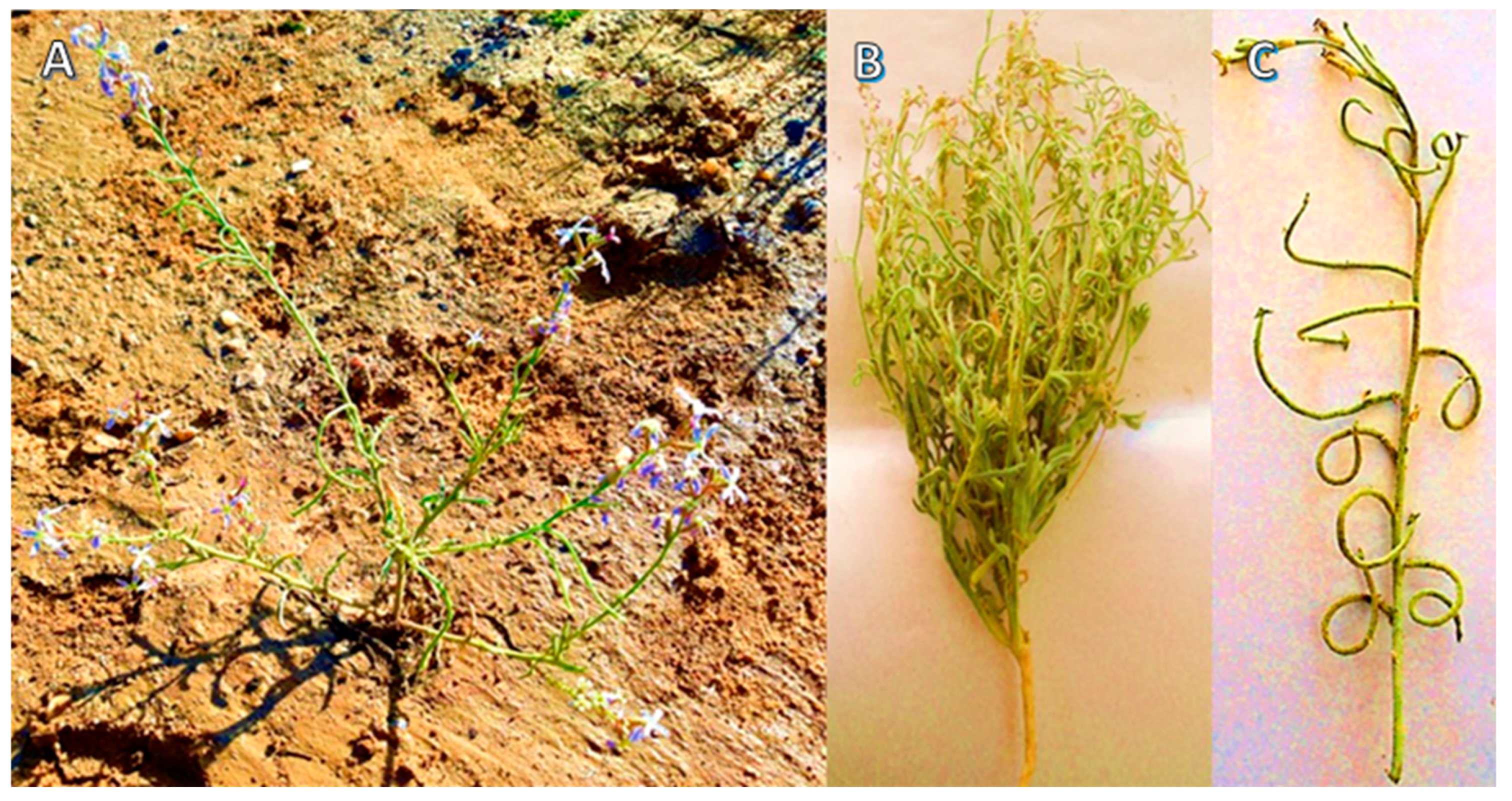
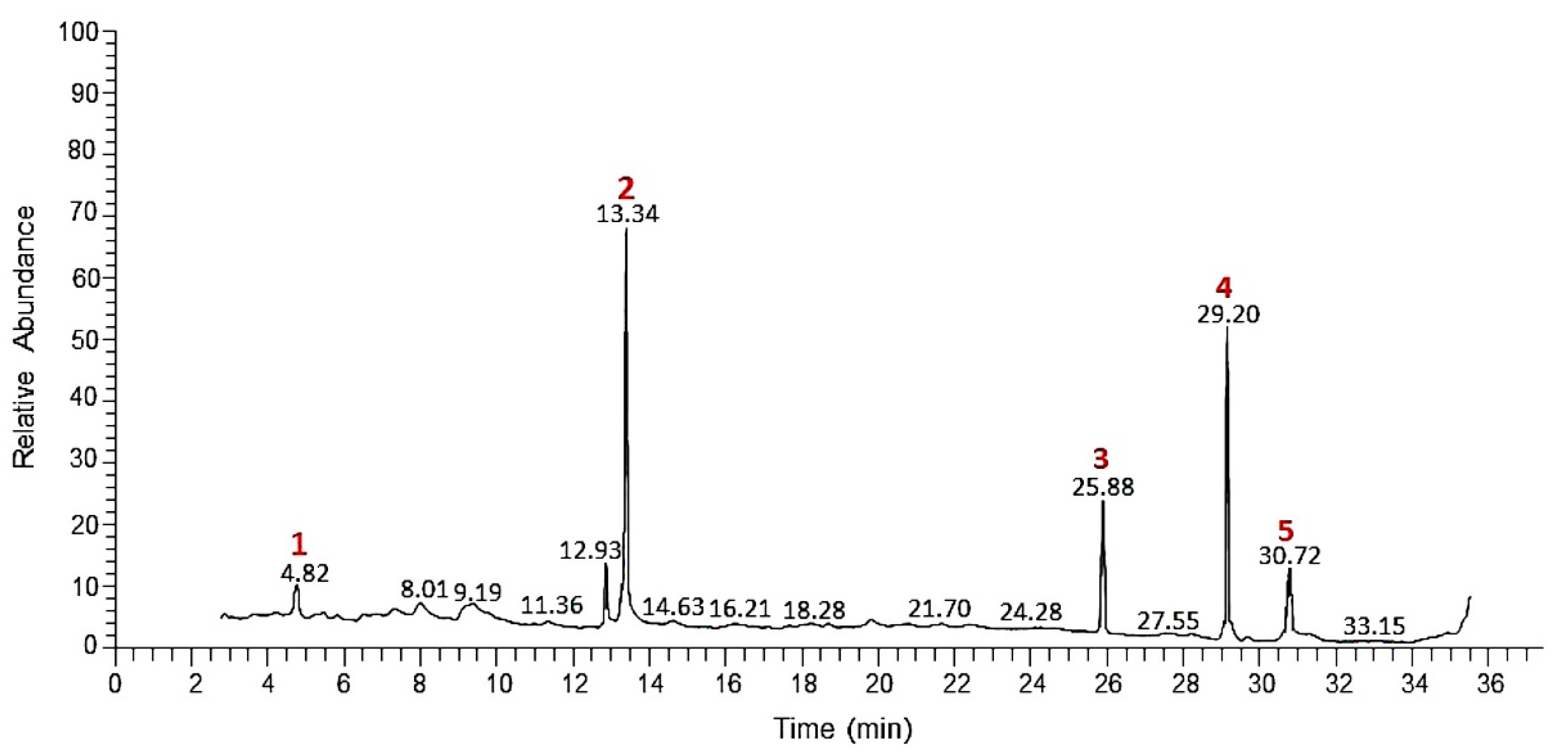
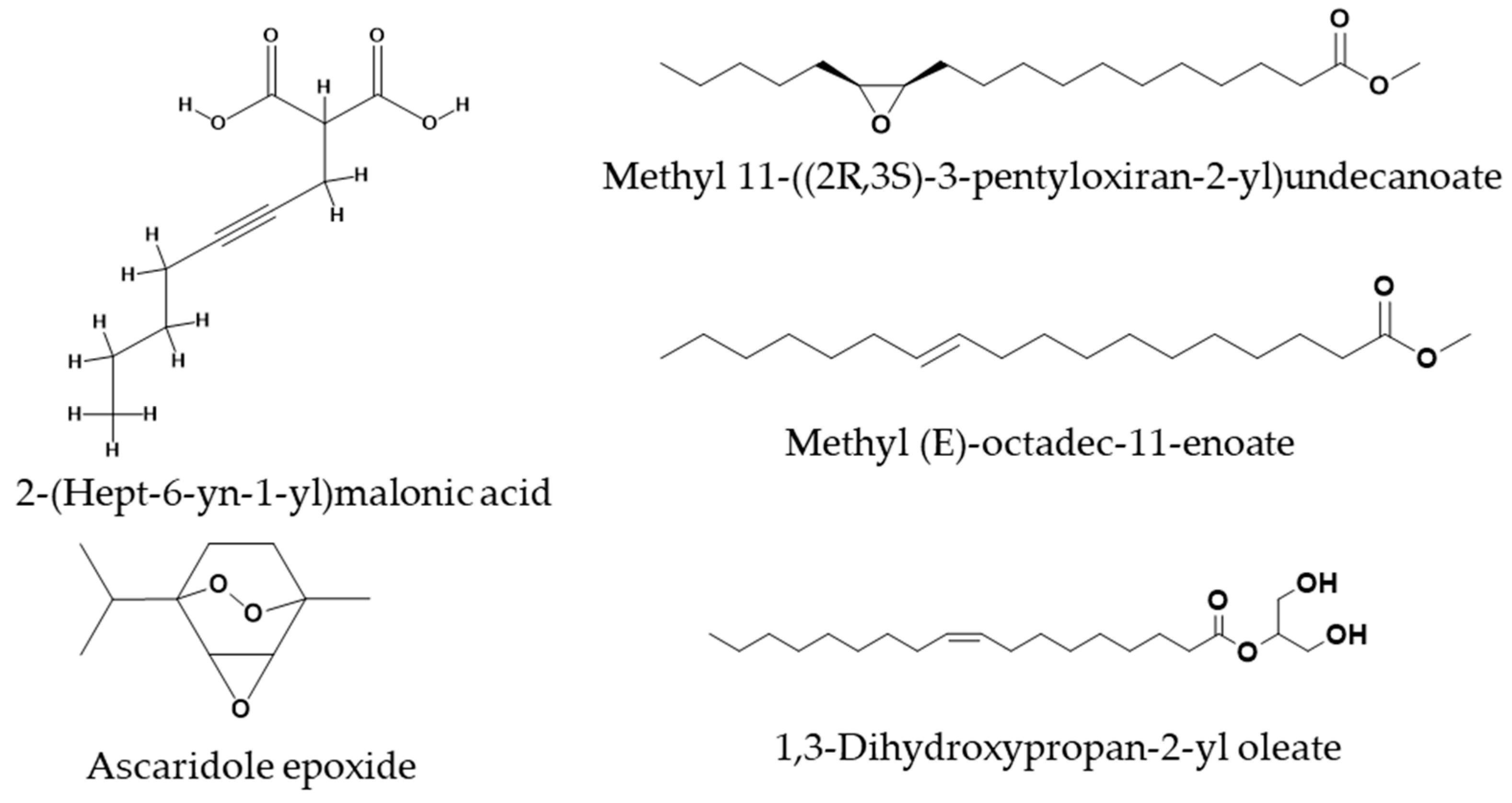

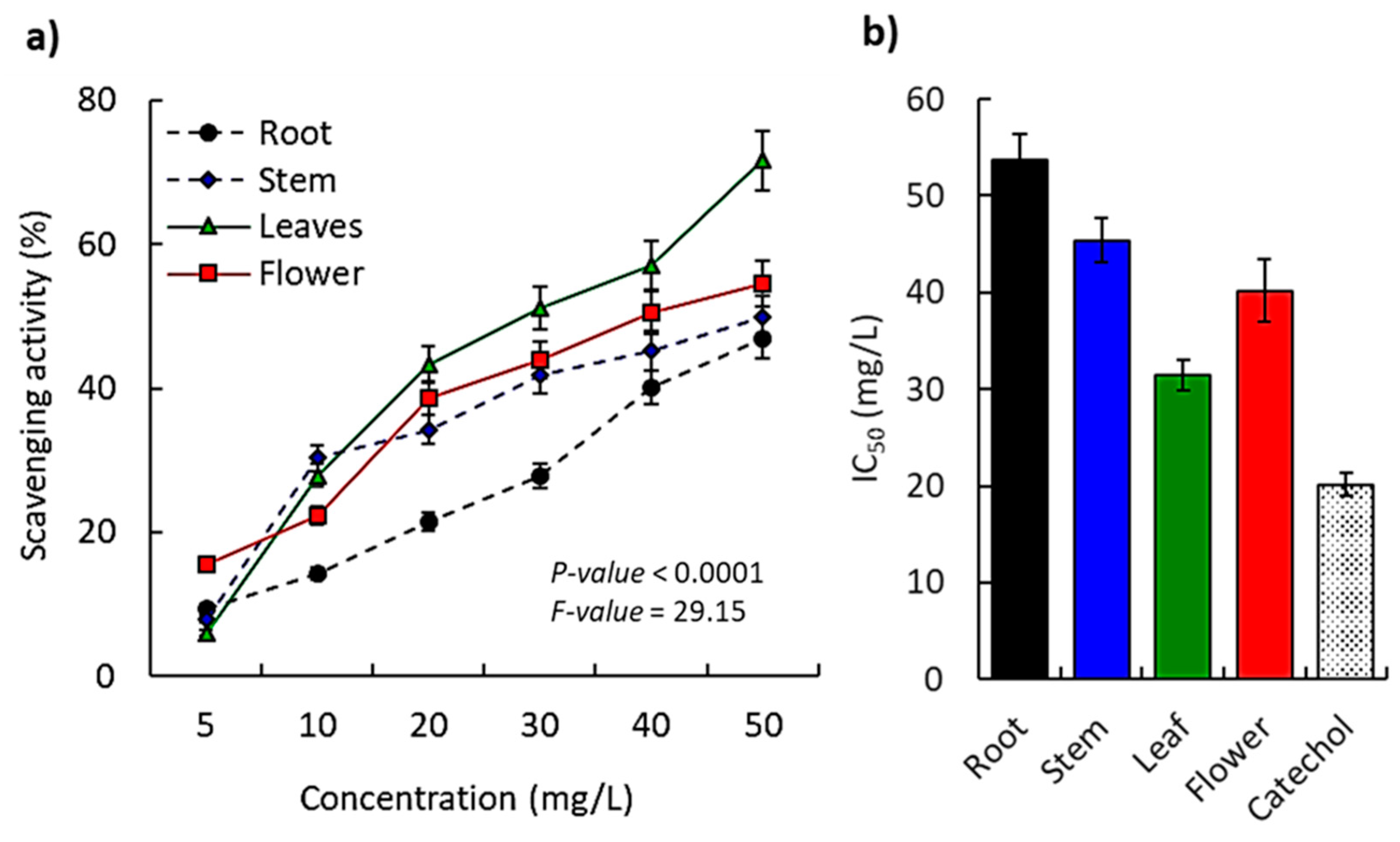
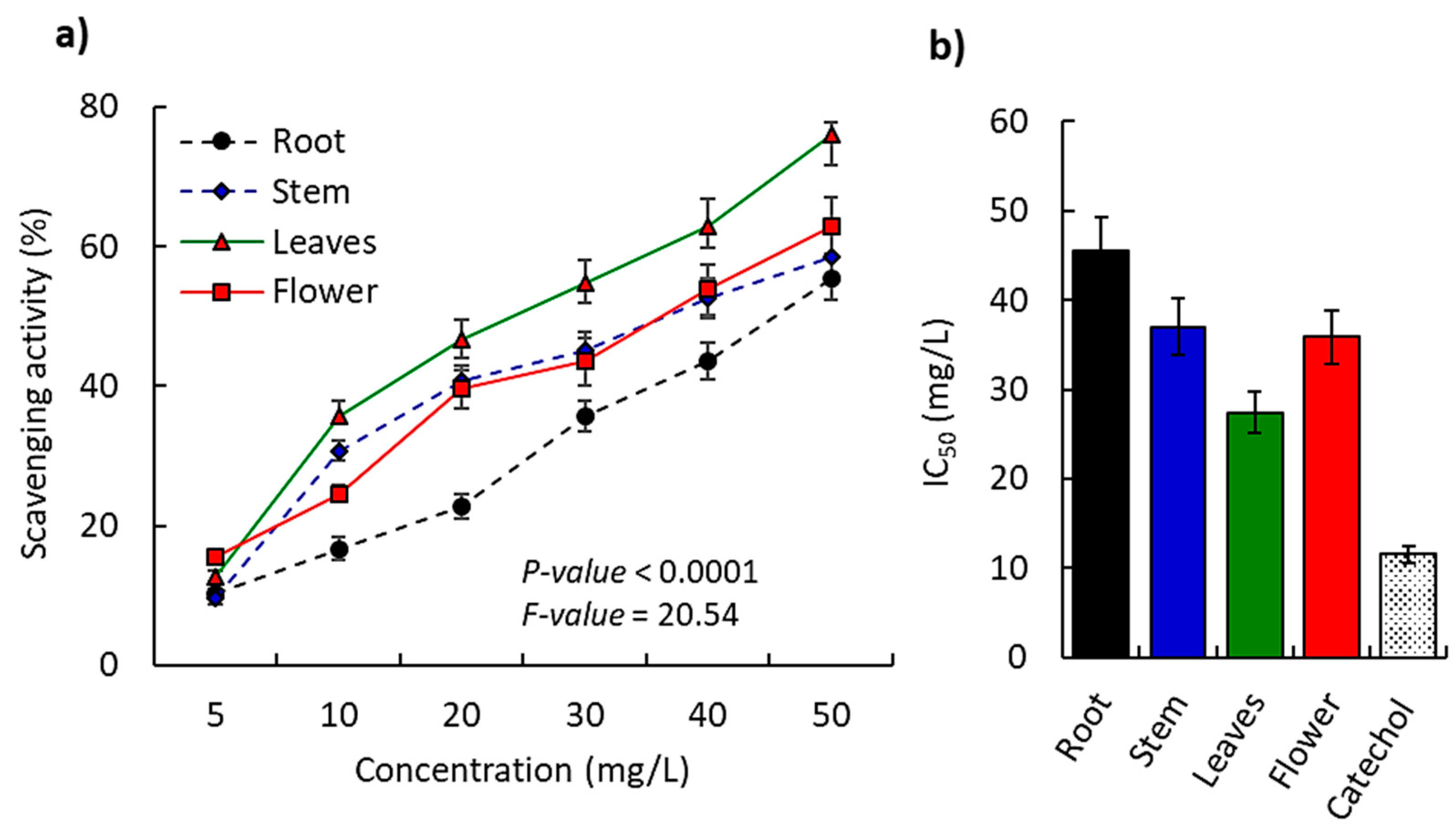



| No. | RT | Conc. % | Chemical Name | Classification | MW | MF |
|---|---|---|---|---|---|---|
| Oxygenated hydrocarbon | ||||||
| 1 | 4.23 | 0.81 ± 0.02 | (E)-2-(1-(2-(2-methylpiperidine-1-carbonothioyl)hydrazono)ethyl)pyridine 1-oxide | Aryl hydrocarbon | 292.4 | C14H20N4OS |
| 2 | 4.82 | 4.73 ± 0.03 | 2-(Hept-6-yn-1-yl)malonic acid | Aliphatic carboxylic acid | 453.44 | C16H15N5O7S2 |
| 3 | 5.16 | 0.89 ± 0.02 | 3-(2-Oxocyclohexyl)propanenitrile | Oxygenated hydrocarbon | 151.21 | C9H13NO |
| 4 | 5.61 | 1.99 ± 0.01 | Methyl 3,5-dioxohexahydro-1H-pyrrolizine-2-carboxylate | Ester | 197.19 | C9H11NO4 |
| 5 | 9.32 | 2.46 ± 0.01 | (3R,4S,5R)-3,4-Dihydroxy-5-(1,2,3,4-tetrahydroxybutyl)dihydrofuran-2(3H)-one | Oxygenated hydrocarbon | 238.19 | C8H14O8 |
| 6 | 9.4 | 3.68 ± 0.02 | Ethyl 2-hydroxycyclohexane-1-carboxylate | Ester | 172.22 | C9H16O3 |
| 7 | 12.93 | 4.08 ± 0.03 | (2Z,3E)-2-ethylidene-6-methylhepta-3,5-dienal | Oxygenated hydrocarbon | 150.22 | C10H14O |
| 8 | 16.32 | 0.51 ± 0.02 | 9,10-Secocholesta-5,7,10(19)-triene-1,3-diol, 25-[(trimethylsilyl)oxy]-, (3á,5Z,7E)- | Oxygenated hydrocarbon | 488.83 | C30H52O3Si |
| Carbohydrates | ||||||
| 9 | 8.01 | 4.09 ± 0.02 | 1-S-[(1E)-N-Hydroxy-3-butenimidoyl]-1-thiohexopyranose | Glycoside | 279.31 | C10H17NO6S |
| 10 | 8.72 | 0.33 ± 0.00 | α-D-Glucopyranoside, O-α-D-glucopyranosyl-(1.fwdarw.3)-α-D-fructofuranosyl | Trisaccharide | 504.44 | C18H32O16 |
| 11 | 8.77 | 0.38 ± 0.01 | 2,3,4,5,6,7,8-Heptahydroxyoctanamide | Glycosyl amide | 255.22 | C8H17NO8 |
| 12 | 9.19 | 4.15 ± 0.02 | 2-(Acetylamino)-2-deoxyhexopyranose | Carbohydrate | 221.21 | C8H15NO6 |
| 13 | 17.68 | 1.26 ± 0.01 | (2R,3S,4S,5R,6R)-2-(Aminomethyl)-6-(((2R,3S,4R,6S)-4,6-diamino-3-(((3R,4R,5R)-3,5-dihydroxy-5-methyl-4-(methylamino)tetrahydro-2H-pyran-2-yl)oxy)-2-hydroxycyclohexyl)oxy)tetrahydro-2H-pyran-3,4,5-triol | Aminoglycoside | 482.53 | C19H38N4O10 |
| Amines | ||||||
| 14 | 4.15 | 1.71 ± 0.02 | 2-Ethylidene-1,5-dimethyl-3,3-diphenylpyrrolidine | Diaryl cyclic amine | 277.41 | C20H23N |
| 15 | 6.89 | 0.89 ± 0.01 | 1,3,5-Triazine-2,4-diamine,N,N’-bis(1-methylethyl)-6-(methylsulfonyl)- | Hetryl amine | 273.36 | C10H19N5O2S |
| 16 | 9.25 | 2.25 ± 0.02 | 4-Amino-1,5-pentandioic acid | Amino acid | 175.18 | C7H13NO4 |
| Terpenoids | ||||||
| 17 | 13.34 | 12.71 ± 0.21 | Ascaridole epoxide | Bicyclic monoterpenoid | 184.24 | C10H16O3 |
| Fatty acids and Lipids | ||||||
| 18 | 4.38 | 0.53 ± 0.02 | Hexyl oleate | Fatty acid | 366.63 | C24H46O2 |
| 19 | 4.7 | 3.60 ± 0.01 | 2-(Hept-6-yn-1-yl)malonic acid | Oleic acid | 450.4 | C21H22O11 |
| 20 | 5.52 | 1.11 ± 0.01 | Palmitic acid | Fatty acid | 256.43 | C16H32O2 |
| 21 | 6.51 | 1.86 ± 0.02 | (E)-Hexadec-9-enoic acid | Fatty acid | 254.41 | C16H30O2 |
| 22 | 6.78 | 0.27 ± 0.00 | 3-(((9Z,12Z,15Z)-Octadeca-9,12,15-trienoyl)oxy)propane-1,2-diyl diacetate | Lipids | 436.59 | C25H40O6 |
| 23 | 7.36 | 3.70 ± 0.02 | 2-(((9Z,12Z)-Octadeca-9,12-dienoyl)oxy)propane-1,3-diyl diacetate | Lipids | 438.61 | C25H42O6 |
| 24 | 9.85 | 0.77 ± 0.01 | Ethyl stearate | Lipids | 312.54 | C20H40O2 |
| 25 | 11.35 | 1.90 ± 0.02 | (Z)-Hexadec-9-enoic acid | Lipids | 254.41 | C16H30O2 |
| 26 | 12.43 | 1.13 ± 0.01 | 3-Hydroxydodecanoic acid | Lipids | 216.32 | C12H24O3 |
| 27 | 14.61 | 2.52 ± 0.01 | (R,Z)-12-Hydroxyoctadec-9-enoic acid | Fatty acid | 298.47 | C18H34O3 |
| 28 | 16.2 | 1.49 ± 0.01 | 8-((2R,3S)-3-Octyloxiran-2-yl)octanoic acid | Lipids | 298.47 | C18H34O3 |
| 29 | 18.27 | 1.38 ± 0.00 | Oleic acid | Fatty acid | 282.47 | C18H34O2 |
| 30 | 19.81 | 2.17 ± 0.02 | 2-Bromotetradecanoic acid | Fatty acid | 307.27 | C14H27BrO2 |
| 31 | 22.36 | 1.63 ± 0.01 | 2,3-Dihydroxypropyl palmitate | Lipids | 330.51 | C19H38O4 |
| 32 | 24.26 | 1.17 ± 0.01 | 2-Hydroxypropane-1,3-diyl dipalmitate | Lipids | 568.92 | C35H68O5 |
| 33 | 25.88 | 7.51 ± 0.03 | Methyl 11-((2R,3S)-3-pentyloxiran-2-yl)undecanoate | Lipids | 312.49 | C19H36O3 |
| 34 | 29.2 | 12.21 ± 0.37 | Methyl (E)-octadec-11-enoate | Lipids | 296.5 | C19H36O2 |
| 35 | 30.72 | 5.85 ± 0.04 | 1,3-Dihydroxypropan-2-yl oleate | Lipids | 356.55 | C21H40O4 |
| Steroids | ||||||
| 36 | 21.68 | 0.87 ± 0.01 | Estra-1,3,5(10)-trien-17β-ol | Steroid | 256.39 | C18H24O |
| 37 | 31.43 | 1.39 ± 0.01 | Ethyl 3,7,12-trihydroxycholan-24-oate | Steroidal ester | 436.63 | C26H44O5 |
| Total | 99.98 | |||||
| Microbes | M. longipetala (10 mg/L) | Standard Antibiotic (10 mg/L) | ||||||
|---|---|---|---|---|---|---|---|---|
| Root | Stem | Leaf | Flower | Ampicillin | Azithromycin | Cefotaxime | Tetracycline | |
| Gram-negative bacteria | ||||||||
| E. coli | 11 ± 0.51 a | 12 ± 0.21 | 15 ± 0.57 | 15 ± 0.31 | 19 ± 0.46 | 19 ± 0.31 | 28 ± 0.71 | 17 ± 0.58 |
| P. aeruginosa | NA | NA | NA | NA | NA | 14 ± 0.65 | 9 ± 0.45 | NA |
| S. typhimurium | NA | NA | NA | NA | NA | NA | 9 ± 0.22 | 9 ± 0.34 |
| K. pneumoniae | 12 ± 0.44 | 10 ± 0.51 | 10 ± 0.66 | 12 ± 0.70 | 6 ± 0.08 | 11 ± 0.51 | 18 ± 0.43 | 19 ± 0.33 |
| Gram-positive bacteria | ||||||||
| S. epidermidis | 10 ± 0.27 | 10 ± 0.32 | 10 ± 0.09 | 10 ± 0.68 | 9 ± 0.20 | 21 ± 0.62 | 18 ± 0.55 | 18 ± 0.62 |
| S. aureus | 15 ± 0.41 | 12 ± 0.20 | 15 ± 0.33 | 15 ± 0.50 | 27 ± 0.87 | 18 ± 0.81 | 20 ± 0.53 | 18 ± 0.44 |
| S. haemolyticus | 11 ± 0.22 | 10 ± 0.11 | 12 ± 0.41 | 12 ± 0.69 | 18 ± 0.71 | 21 ± 0.53 | 6 ± 0.66 | 21 ± 0.48 |
| S. xylosus | NA | NA | NA | 6 ± 0.54 | 23 ± 0.30 | 17 ± 0.50 | 16 ± 0.35 | 19 ± 0.53 |
| p-value 0.05b | ˂0.001 *** | ˂0.001 *** | ˂0.001 *** | ˂0.001 *** | ˂0.001 *** | ˂0.001 *** | ˂0.001 *** | ˂0.001 *** |
| Conc. (µg/mL) | Cell Viability (%) | Standard Deviation | ||
|---|---|---|---|---|
| R1 | R2 | Average | ||
| 1000 | 76.46 | 73.92 | 75.19 | 1.79 |
| 500 | 92.31 | 92.31 | 92.31 | 0.00 |
| 125 | 115.38 | 115.38 | 115.38 | 0.00 |
| 62.5 | 117.69 | 118.46 | 118.08 | 0.54 |
| 31.3 | 119.23 | 123.08 | 121.15 | 2.72 |
| 0 | 100.00 | 100.00 | 100.00 | 0.00 |
Disclaimer/Publisher’s Note: The statements, opinions and data contained in all publications are solely those of the individual author(s) and contributor(s) and not of MDPI and/or the editor(s). MDPI and/or the editor(s) disclaim responsibility for any injury to people or property resulting from any ideas, methods, instructions or products referred to in the content. |
© 2023 by the authors. Licensee MDPI, Basel, Switzerland. This article is an open access article distributed under the terms and conditions of the Creative Commons Attribution (CC BY) license (https://creativecommons.org/licenses/by/4.0/).
Share and Cite
El-Amier, Y.A.; Zaghloul, N.S.; Abd-ElGawad, A.M. Bioactive Chemical Constituents of Matthiola longipetala Extract Showed Antioxidant, Antibacterial, and Cytotoxic Potency. Separations 2023, 10, 53. https://doi.org/10.3390/separations10010053
El-Amier YA, Zaghloul NS, Abd-ElGawad AM. Bioactive Chemical Constituents of Matthiola longipetala Extract Showed Antioxidant, Antibacterial, and Cytotoxic Potency. Separations. 2023; 10(1):53. https://doi.org/10.3390/separations10010053
Chicago/Turabian StyleEl-Amier, Yasser A., Nouf S. Zaghloul, and Ahmed M. Abd-ElGawad. 2023. "Bioactive Chemical Constituents of Matthiola longipetala Extract Showed Antioxidant, Antibacterial, and Cytotoxic Potency" Separations 10, no. 1: 53. https://doi.org/10.3390/separations10010053







